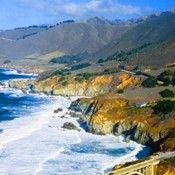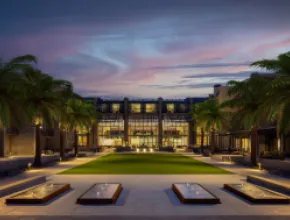The Northern California coast reflects just about every iconic image of California, from the waters of the Pacific to Wine Country and redwood forests. In-between are small towns with long histories and the gamut of urban amenities, such as spas, top-tier restaurants
and unique shopping. There are outdoor adventures to suit every taste and myriad cultural attractions.
Monterey/Carmel/Big Sur
Much of Northern California’s star power falls into Monterey County, which includes the tourist draws of Big Sur, 17-Mile Drive, Pebble Beach and historic Cannery Row, now home to myriad seafood restaurants and shops.
“We’re an upscale destination,” says Bruce Skidmore, director of sales for the Monterey County CVB, adding that with the current economic climate, there has been a shift in group clientele. “The people who would normally meet in a destination like this are going to downtown locations, but people who would normally go offshore are coming places like here. I’m pleasantly surprised by new incentive programs coming. That’s encouraging.”
Skidmore also notes an increase in requests for help from the bureau.
“A lot of meeting planners are turning to bureaus now. A lot of corporations are having staff cuts. One fired its entire meeting department except the coordinator,” he says. “They are turning to intermediaries and outsourcing or turning to bureaus to do the legwork for them.”
The result has been a doubling in the number of room nights booked through the bureau so far this year compared with the same period from last year.
The county is divided into distinct towns, each with its own appeal. Downtown Monterey is the predominant meeting hotel headquarters of the county and home to the Monterey County Conference Center (MCC), a member of the Monterey Meeting Connection, an association that includes the MCC, the Hotel Pacific, the Portola Hotel & Spa at Monterey Bay and the Monterey Marriott. The Hilton Garden Inn in Monterey is another group option, as is the Monterey Plaza Hotel & Spa, which recently received a Mobil Four-Star Award.
“The Monterey Bay Aquarium continues to be the big anchor of Monterey and Pacific Grove,” Skidmore says.
The aquarium recently replaced its jellyfish display with a new seahorse exhibit. Groups can host off-site functions at the aquarium.
Meanwhile, Adventures by the Sea arranges beach parties and aquatic adventures for groups.
Carmel Valley touts several wineries and tasting rooms, including Chateau Julien Wine Estate, a culinary institute open to private events. The town of Carmel-by-the-Sea, filled with quaint cobblestone streets, has its quirks, including an ordinance against wearing high heels and a complete dearth of traffic lights. Carmel is a top spot for perusing art galleries, one-of-a-kind boutiques and a variety of pubs and restaurants.
Pacific Grove is an old-style town dotted with bed-and-breakfast properties and charming inns. It is home to the 107-acre Asilomar Conference Grounds, which features 30,000 square feet of meeting space.
The perpetually popular Mazda Raceway Laguna Seca offers a full calendar of events as well as opportunities for groups. The Steinbeck Center in Salinas hosts groups for private events.
Outdoor activities include whale watching and beach combing, as well as hiking in Point Lobos State Reserve. Golf is also a draw, including the seaside courses in Pebble Beach and the annual AT&T Pebble Beach National Pro Am.
Pebble Beach also features beachfront hotels such as the Inn at Spanish Bay and The Lodge at Pebble Beach.
About 25 miles south of Carmel is Big Sur, renowned for its oceanfront cliffs and idyllic vistas along Highway 1. Big Sur is a haven for small groups seeking a coastal escape, and one option for executive retreats and other intimate gatherings is Ventana Inn & Spa, which recently finished a renovation that included the addition of meeting space.
Santa Cruz
Just north of Monterey, Santa Cruz County encompasses the town of Santa Cruz as well as the smaller communities of Capitola, Davenport, Soquel, Aptos, Ben Lomond, Felton and Boulder Creek, among others.
“What makes us unique is our variety of settings in a small amount of space,” says Christina Glynn, communications director of the Santa Cruz County Conference and Visitors Council. “You can go from coastal redwoods to the beach in a matter of minutes. We have a reputation for natural beauty and being a laid-back beach community.”
Groups can experience the Santa Cruz Beach Boardwalk for its amusement rides and use Cocoanut Grove next to the boardwalk for its more than 20,000 square feet of meeting and banquet space.
Roaring Camp Railroads in Felton offers rides to Bear Mountain as well as team-building games on the lawn at Roaring Camp. Groups can also host events at many of the wineries in the county, including Ridge Winery.
Another off-site option for small groups is the Seymour Marine Discovery Center, a working marine lab and aquarium run by the University of California Santa Cruz.
The surfing museum, housed in a lighthouse, is a popular stop, chronicling over 120 years of surfing in Santa Cruz. The museum overlooks Steamer Lane, one of the best places in the country to surf. Groups can sign up for kayaking adventures and surf schools, or organize an outing on the Chardonnay II, a 70-foot-long luxury yacht.
Chaminade Resort, a group favorite, recently renovated its spa, while the Santa Cruz Dream Inn is reconfiguring its conference space. The property is now managed by Joie de Vivre Hospitality. Other area options for conference space include the Scotts Valley Hilton, Seascape Beach Resort and University Inn.
Team-building opportunities include culinary workshops at Seascape Beach Resort. Seascape also calls on a local musician to orchestrate drumming circles on the beach.
“That is something unique to Santa Cruz and is the essence of Santa Cruz,” Glynn says.
San Mateo County
Sandwiched between the Pacific Coast and San Francisco Bay, San Mateo County lures visitors with its waterfront appeal as well as its accessibility, with San Francisco International Airport (SFO) located at the heart of the county.
“The good news that we mention to planners is that there are so many airports that have cut service from feeder airports, but at SFO that’s not the case—they have been solid. Virgin, JetBlue and Southwest continually add feeder cities,” says Anne LeClair, president and CEO of the San Mateo County/Silicon Valley CVB.
It can also offer cost savings compared to some of the surrounding areas.
“We’ve always been a more affordable destination,” LeClair says. “That’s one of the biggest selling points.”
The county average is $60 less per room night than San Francisco. There are also lower rates available for food and beverage and parking than its big city neighbor to the north.
The bureau expanded last year to cover Palo Alto, including facilities at Stanford University such as Cantor Arts Center, home to the world’s second-largest Rodin sculpture.
“This helps because Stanford is a great draw,” LeClair says.
San Mateo County is home to 15,000 hotel rooms, while Palo Alto adds another 2,500. Main group venues include the Cow Palace, South San Francisco Conference Center and the San Mateo County Event Center, in addition to several meetings-friendly hotel options, several along the bay, in communities near SFO.
Groups often stay along the bay and head to the Pacific Coast side for a clam bake, while there are also meetings-ready hotels along the coast, including The Ritz-Carlton, Half Moon Bay and the Beach House Half Moon Bay.
“We’re finding a lot of the planners come out and return with significant others and families on vacation,” LeClair says. “That’s the ultimate testimonial.”
The recently refurbished Fox Theatre in Redwood City opened in 1929 and can host group receptions. Another venue is the Lifemark Center at Skylawn, at the crest of San Mateo County’s coastal range. The center doubles as a funeral home and meeting facility for up to 500 people. Meanwhile, Long Branch Saloon and Farms in Half Moon Bay is a replica Old West town that caters to groups with an outdoor covered barbeque area, a dance area, a saloon and indoor and outdoor meeting areas.
Heading outdoors, groups can tee off at Half Moon Bay Golf Links, go kayaking on the Pacific, take a dinner cruise with Empress Events or host a gathering at Gamble Garden in Palo Alto.
Marin County
Just over the Golden Gate Bridge from San Francisco, Marin County is a natural getaway with options such as hiking at Mount Tamalpais or Point Reyes National Seashore, lounging on Stinson Beach, art hopping in San Anselmo and dining in Sausalito.
Marin also rebranded its product last year with the tagline, “Just a Little Out There.”
“Pound for pound we hold our own with any county in the state for natural amenities,” says Mark Essman, president and CEO of the Marin CVB, noting standout attractions such as Muir Woods and Angel Island. “Even though it’s small, you can be here five days and do 15 different things.”
Marin’s group business has taken a hit from the economic downturn, and the destination is looking to diversify its meetings clientele.
“We’re trying to develop more of a niche market attitude, and we’re really looking at the drive market,” Essman says. “We can provide a non-urban environment in a very urban setting. That gives us a lot of diversity when we go after specific target groups.”
Properties include Tiburon Waters Edge and Tiburon Lodge; Cavallo Point Lodge in Sausalito; and Point Reyes Seashore Lodge and Conference Center in Olema. Farther inland, the Frank Lloyd Wright-designed Marin County Civic Center in San Rafael can host events, while other options include Inn Marin in Novato and Four Points by Sheraton San Rafael.
Sonoma County
Just about the size of Rhode Island, Sonoma County is home to 262 wineries, more than 50 spas, a scenic stretch of the Pacific Coast, San Pablo Bay and what has been called by Food Network star Guy Fieri the epicenter of food and wine. Oceanfront towns such as Bodega Bay are ideal coastal retreats, while inland communities such as Santa Rosa, Petaluma, Healdsburg and the town of Sonoma are also inviting options for groups.
“We really try to sell that we’re a getaway from the city environment,” says Mark Crabb, director of sales for the Sonoma County Tourism Bureau. “It’s easy to get around and you don’t get lost. We push extended stay.”
Though groups have been postponing more than canceling in light of the economy, hotels are stepping up their packaging and offering special rates, according to Crabb.
“It’s a buyers market. If planners are in need of a quick turnaround they are willing to work with them,” Crabb says. “We are pushing customer service and flexibility.”
One new option is a cash incentive program for groups with more than 300 room nights. They can earn up to $4,000 and apply it directly to the master account to help offset costs or to use toward an off-site venue.
Wineries are a main draw, including options such as Rosso & Bianco winery in Geyserville, owned by Francis Ford Coppola; St. Francis Winery and Vineyards; and Chateau St. Jean.
Groups can organize team-building outings such as culinary classes, races at the Jim Russell Racing Drivers School at Infineon Raceway and winemaking instruction at Paradise Ridge Winery, where attendees can blend and create their own wine.
Other off-site venues include the Charles M. Schulz Museum as well as the Luther Burbank Home and Gardens, both in Santa Rosa.
For waterside meetings, property options in Sonoma County include the Bodega Bay Lodge and Spa and The Inn at the Tides, both in Bodega Bay; Sea Ranch Lodge, located in Sea Ranch; Timber Cove Inn, north of Jenner; and Sheraton Sonoma County–Petaluma, set on the bay.
Mendocino and Humboldt Counties
California’s true north brings together towering redwoods and the full force of the Pacific.
Mendocino County is anchored by Ukiah, business central for this rural getaway. Within the county’s confines, Anderson Valley is renowned for its pinot noir, while the whole county is a hub for wineries and breweries. Meanwhile, it’s an outdoor paradise for mountain biking, hiking, canoeing and kayaking, and groups can also charter boats for fishing adventures, cruises and whale-watching expeditions.
Though Mendocino serves mostly small groups, the Mendocino County Promotional Alliance is starting to look more into the group market.
“We’re starting to approach groups,” says Scott Schneider, executive director of the Mendocino County Lodging Association and chair for the Mendocino County Promotional Alliance. “We are starting to go to shows to start selling our destination as a meetings retreat location.”
Meetings-friendly retreats include the Elk Cove Inn & Spa, which is located in Elk and features private beach access and views of the Pacific; and Stevenswood Spa Resort, which overlooks the ocean and is situated just south of Mendocino in the town of Little River.
Meanwhile, the Ukiah Valley Conference Center recently upgraded its wireless capacity and other technology. Just an hour from the center is the heart of redwood country.
“We have the facility to be plugged in, but once you walk away you can be as unplugged as you want,” Schneider says.
Another possible venue for groups is the Skunk Train, a heritage railroad that shuttles passengers on steam and diesel-powered trains through the redwoods between Fort Bragg and Willits.
The Mendocino Arts Center in the town of Mendocino can host events and features four gallery spaces as well as the Helen Schoeni Theatre—home to the Mendocino Theatre Company. The 15,000-square-foot Gualala Arts Center is also now open to groups.
Whale watching is popular, as is kayaking, hiking and biking, as well as horseback riding in the redwoods or on the beach at Ross Ranch or Ricochet Ridge Ranch.
Another unique option is organizing a guided mushroom walk in the woods. Mendocino is home to no less than 3,000 different varieties of mushrooms.
Humboldt County is also the heart of redwood country, with almost half of the old growths remaining in the world.
“We have the tallest redwoods, oldest redwoods and most redwoods,” says Richard Stenger, media and marketing manager for the Humboldt County CVB.
Among the attractions is Avenue of the Giants, a historic stretch of trees spanning 10,000 acres. Redwood National Park boasts a tree more than 379 feet tall, six stories taller than the Statue of Liberty, according to Stenger.
Government and non-profit groups provide frequent business. Humboldt State University also attracts conferences, and is known nationally for its natural sciences and environmental sustainability studies, drawing small conferences to the area.
The Humboldt Bay Aquatic Center on Eureka’s waterfront features conference and meeting space and is run by Humboldt State University. Also in Eureka, the Arkley Center for the Performing Arts is open to groups and can seat up to 770.
Eureka and the surrounding communities offer 177,700 square feet of meeting space and 2,025 guest rooms at over 60 different venues. Red Lion is the biggest hotel in Eureka, with 5,000 square feet of meeting and banquet facilities. Fortuna offers the River Lodge Conference Center overlooking the Eel River, with 13,000 square feet of meeting space.
For More Info
Humboldt County CVB
707.443.5097 www.redwoodvisitor.org
Marin CVB 415.925.2060 www.visitmarin.org
Mendocino County Promotional Alliance 707.462.7417 www.gomendo.com
Monterey County CVB 831.657.6400 www.montereyinfo.org
Monterey Meeting Connection 831.646.3770 www.montereyconnection.com
San Mateo County CVB 650.348.7600 www.sanmateocountycvb.com
Santa Cruz County Conference and Visitors Council 831.425.1234 www.santacruzca.org
Sonoma County Tourism Bureau 707.522.5800 www.sonomacounty.com







